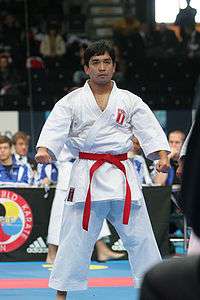Red belt (martial arts)

A red belt is one of several colored belts used in some martial arts where each practitioner's level is marked by the color of the belt, these are most commonly those of Kodokan style Judo origin. Like the more commonly known Black Belt, its use varies between arts, with most using it for the style founder, Grandmaster or other high rank, while others use it as the immediately pre–black belt rank or even to denote a beginner who holds no rank. In some schools, a red belt signifies ninth or tenth degree Dan rank, where the tenth degree is the highest rank attainable.[1]
In karate, even though grandmasters and non–black belts (according to whatever system) may both wear a "red belt", the difference is obvious. Not only is there a clear difference in age, but the respective belts are different, as well: Dan rank belts are broader, with kyu (pre–black belt) rank belts normally having a width of 4 centimeters and dan rank belts having a width of 5 centimeters. Also, the grandmaster's red belt is usually darker in color and embroidered with the person's name and style (as customary for dan rank belts).
- In Brazilian Jiu-Jitsu, the 7th degree belt is red and black, the 8th degree belt is red and white, and the 9th and 10th degree belts are solid red.[2]
- In the Japanese martial art of Judo, at 6th degree (dan) the belt is replaced by an alternately red and white belt, and at 9th degree it is replaced by a solid red belt.[3]
- In most Okinawan Karate styles and in some schools of Kobudo (Okinawan weaponry), the alternately red and white belt is used for seventh and eighth dans, whereas the solid red belt is used for ninth and tenth dans, which are purely honorary, i.e. cannot be attained by applying for (and passing) the respective exam. From seventh dan onwards, a practitioner is allowed to use the title shihan, which translates as "expert examples".
- In modern Karate, as governed by the World Karate Federation and its subsidiary federations, red (aka) and blue (ao) belts are worn by competitors. Only red and blue belts are to be worn for competition, with foot and fist pads of the corresponding color for kumite competition. In tournaments sanctioned by the Japan Karate Association (JKA), red (aka) and white (shiro) belts (colors of the Japanese flag)were previously worn. However, this practice has largely been replaced after the 1980s, with both competitors now wearing black belts and the athlete designated as aka wearing a thin red tassel on his/her belt.
- Usually in traditional Korean taekwondo, the red belt is just before gaining a first degree black belt, or first Dan. The pattern, or poomsae, which must be learned by the practitioner in order to attain the rank varies between styles and schools.
- In Tsien Tao Chinese Kempo, the red belt is equivalent to a sixth degree black belt (first degree master). Stripes are added to the red belt to denote second, and third degree master. A fourth degree master is represented by a red and white striped belt.
- In Seiki Juku Karate, a red belt denotes karate-ka at 10th Kyu.[4]
- In Vovinam, red belt is highest rank for master rank, and they have seven levels, from zero to six.
References
- ↑ Belt colors and ranking tradition. E-budokai.com (2010-09-09). Retrieved on 2012-04-24.
- ↑ Jiu-jitsu Newbie Guide – FAQs: Information for Beginners about Brazilian Jiu-jitsu. Jiu-jitsu.net. Retrieved on 2012-04-24.
- ↑ The Judo Rank System – Belts. Judoinfo.com. Retrieved on 2012-04-24.
- ↑ http://yawaramartialarts.com/more/more_karate_syllabus.html